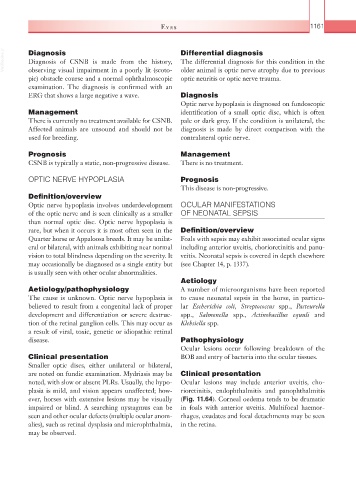Page 1186 - Equine Clinical Medicine, Surgery and Reproduction, 2nd Edition
P. 1186
Eyes 1161
VetBooks.ir Diagnosis Differential diagnosis
The differential diagnosis for this condition in the
Diagnosis of CSNB is made from the history,
observing visual impairment in a poorly lit (scoto-
pic) obstacle course and a normal ophthalmoscopic older animal is optic nerve atrophy due to previous
optic neuritis or optic nerve trauma.
examination. The diagnosis is confirmed with an
ERG that shows a large negative a wave. Diagnosis
Optic nerve hypoplasia is diagnosed on fundoscopic
Management identification of a small optic disc, which is often
There is currently no treatment available for CSNB. pale or dark grey. If the condition is unilateral, the
Affected animals are unsound and should not be diagnosis is made by direct comparison with the
used for breeding. contralateral optic nerve.
Prognosis Management
CSNB is typically a static, non-progressive disease. There is no treatment.
OPTIC NERVE HYPOPLASIA Prognosis
This disease is non-progressive.
Definition/overview
Optic nerve hypoplasia involves underdevelopment OCULAR MANIFESTATIONS
of the optic nerve and is seen clinically as a smaller OF NEONATAL SEPSIS
than normal optic disc. Optic nerve hypoplasia is
rare, but when it occurs it is most often seen in the Definition/overview
Quarter horse or Appaloosa breeds. It may be unilat- Foals with sepsis may exhibit associated ocular signs
eral or bilateral, with animals exhibiting near normal including anterior uveitis, chorioretinitis and panu-
vision to total blindness depending on the severity. It veitis. Neonatal sepsis is covered in depth elsewhere
may occasionally be diagnosed as a single entity but (see Chapter 14, p. 1337).
is usually seen with other ocular abnormalities.
Aetiology
Aetiology/pathophysiology A number of microorganisms have been reported
The cause is unknown. Optic nerve hypoplasia is to cause neonatal sepsis in the horse, in particu-
believed to result from a congenital lack of proper lar Escherichia coli, Streptococcus spp., Pasteurella
development and differentiation or severe destruc- spp., Salmonella spp., Actinobacillus equuli and
tion of the retinal ganglion cells. This may occur as Klebsiella spp.
a result of viral, toxic, genetic or idiopathic retinal
disease. Pathophysiology
Ocular lesions occur following breakdown of the
Clinical presentation BOB and entry of bacteria into the ocular tissues.
Smaller optic discs, either unilateral or bilateral,
are noted on fundic examination. Mydriasis may be Clinical presentation
noted, with slow or absent PLRs. Usually, the hypo- Ocular lesions may include anterior uveitis, cho-
plasia is mild, and vision appears unaffected; how- rioretinitis, endophthalmitis and panophthalmitis
ever, horses with extensive lesions may be visually (Fig. 11.64). Corneal oedema tends to be dramatic
impaired or blind. A searching nystagmus can be in foals with anterior uveitis. Multifocal haemor-
seen and other ocular defects (multiple ocular anom- rhages, exudates and focal detachments may be seen
alies), such as retinal dysplasia and microphthalmia, in the retina.
may be observed.

